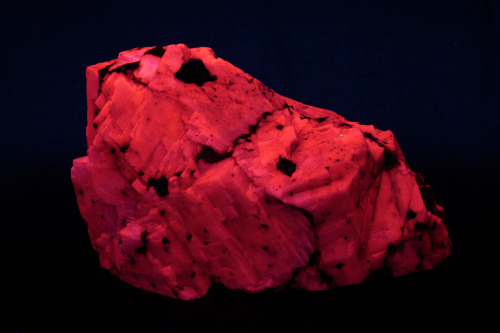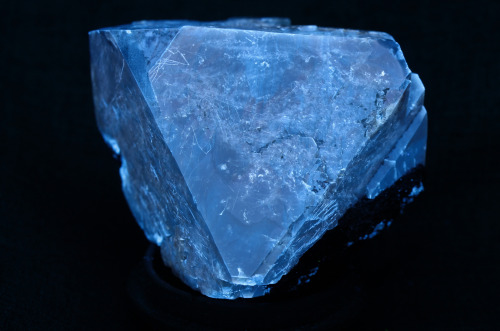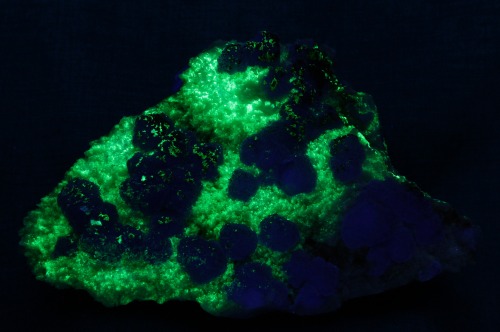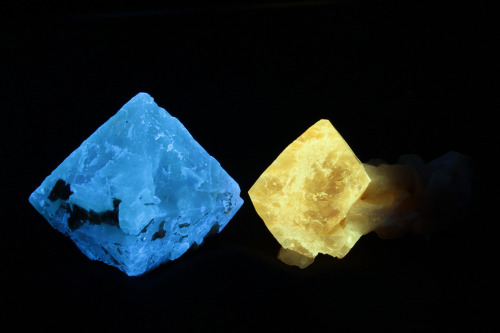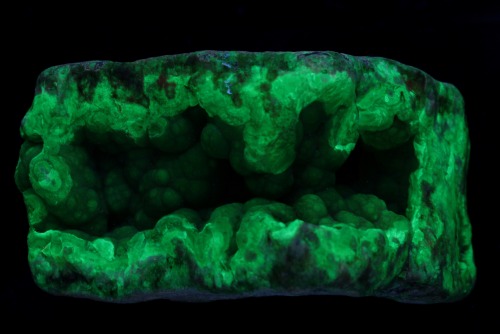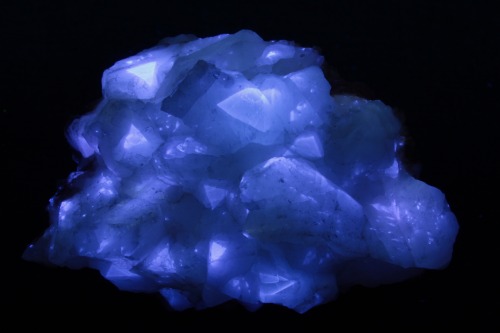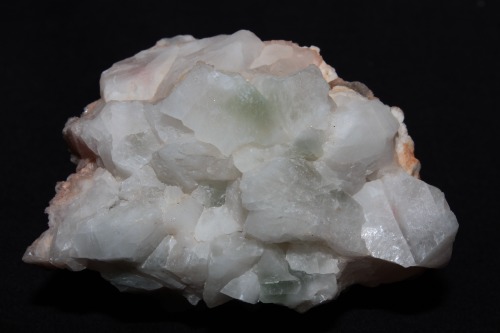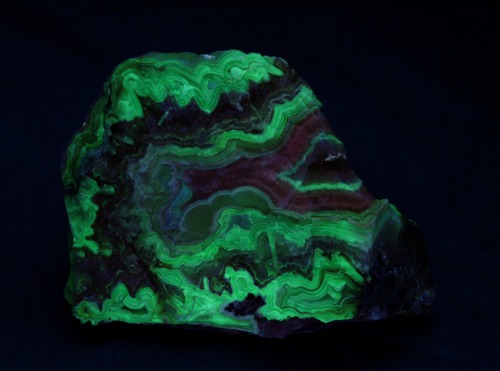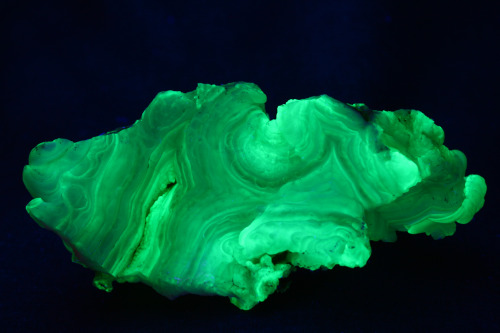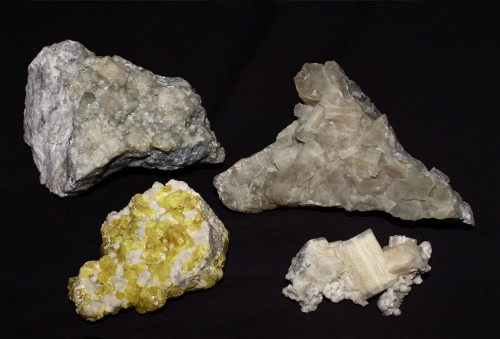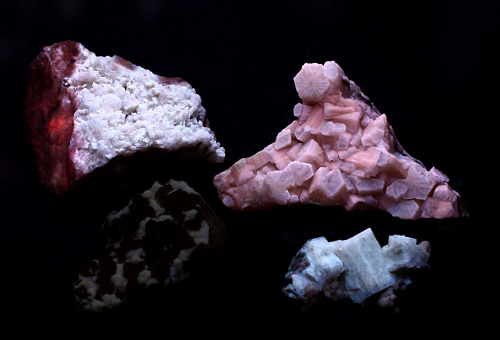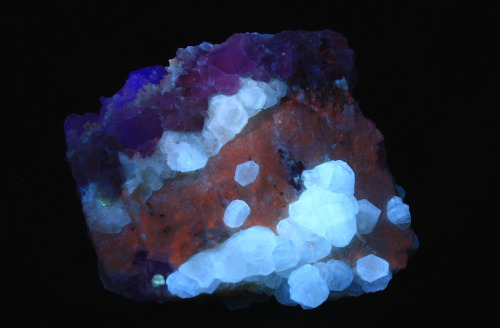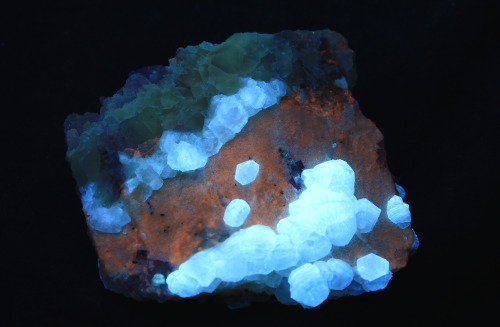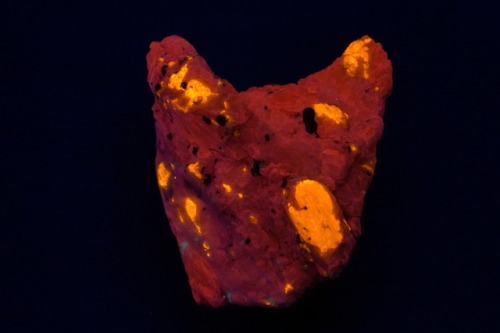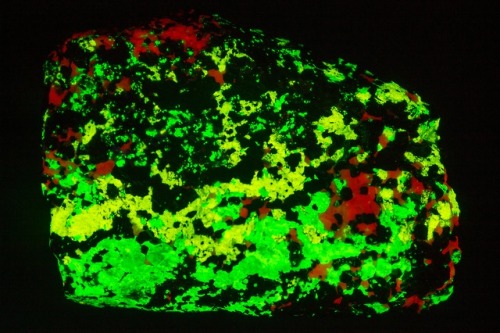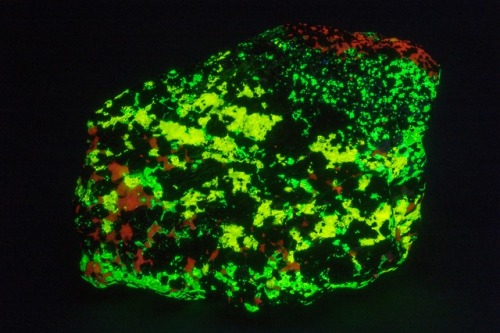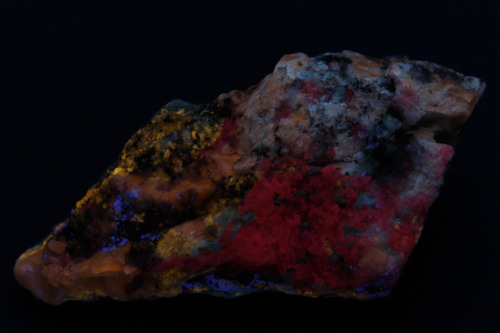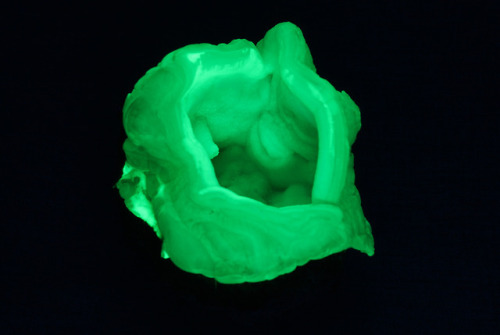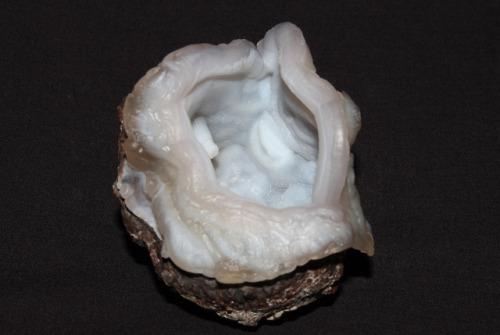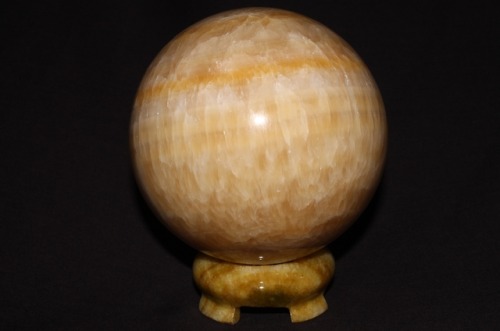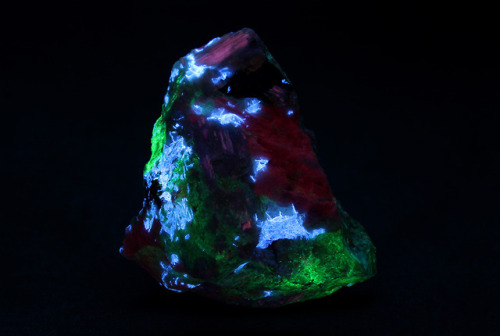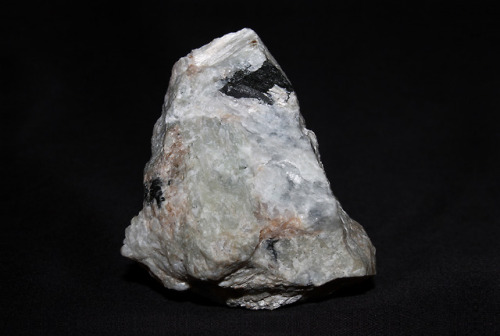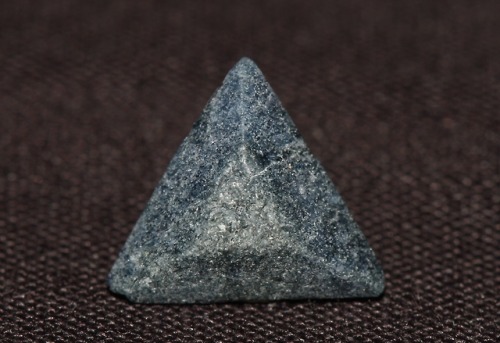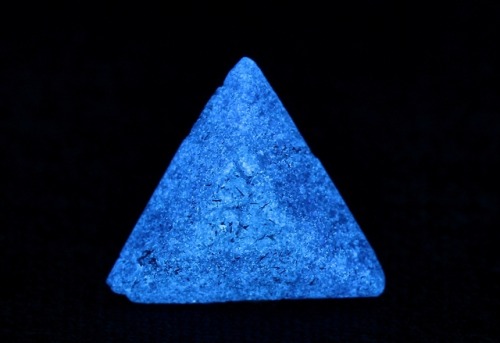#short wave ultraviolet


Mixed fluorescent minerals from the Beltana Mine (Puttapa Zinc Mine), Leigh Creek, North Flinders Ranges, Flinders Ranges, South Australia, Australia. Pictured under short wave ultraviolet and white light.


Benitoite from the Benitoite Gem Mine, San Benito County, CA, under white light and short wave ultraviolet. Benitoite is California’s State Gemstone. It crystalizes in the rare ditrigonal dipyramidal crystal class.




Terlingua Calcite from the Little 38 Mine in Terlingua, Texas. All of the fluorescent minerals in this rock are calcite. Shown under long wave ultraviolet, mid-wave ultraviolet, short wave ultraviolet and white light. This one weighs over 8 pounds.




Fluorescent mineral display at the 64th Annual Dallas Gem & Mineral Society Show, November 20-21, 2021. The case is illuminated with long wave ultraviolet light on the left side, and short wave ultraviolet on the right. Note that many of the minerals in the center of the display exhibit different color responses under long wave vs. short wave.
Calcite from the Buckwheat Dump at the Franklin Mineral Museum, Franklin, NJ. Pictured under long wave, mid-wave, and short wave ultraviolet, and white light.
Post link
Black/gray/brown scheelite crystal from the Tae Hwa Mine, North Chungcheong Province, South Korea. Scheelite is an ore of tungsten. Shown exhibiting the classic blue fluorescence under short wave ultraviolet light, under white light, and showing the red fluorescence that is sometimes seen under mid-wave ultraviolet light. The nearly equilateral triangle edges measure approximately 1 ¾ inches or 4.4 cm.
Post link
Fluorite on hyalite reportedly from the La Lupita Mine in Durango, Chihuahua, Mexico. Pictured under short wave + long wave ultraviolet, white light, short wave only, and long wave only. The hyalite is best under short wave uv and the fluorite is best under long wave uv.
Post link
End members of the scheelite-powellite series. Scheelite from Mt. Xuebaoding, China, and powellite with stilbite from Nasik, Maharashtra, India. Pictured under short wave ultraviolet and white light.
Post link
The tag says “Botryoidal Seam Agate” with no location listed. If anyone recognizes it, please let me know! It measures 4″ x 2″ x 2″. Shown under white light and short wave ultraviolet.
Post link
Terlingua Calcite from the Little 38 Mine, Terlingua, Texas. Pictured under long wave, mid-wave, and short wave ultraviolet and white light.
Post link
Benitoite from the Benitoite Gem Mine in San Benito County, California, the type locality. Benitoite is a rare blue barium titanium silicate mineral and is considered to be one of the rarest minerals/gemstones in the world. It was discovered in 1907 and is the State Gemstone of California. According to www.minerals.net, “The crystal structure of Benitoite is unique, and is the only significant mineral in its crystal class. It crystallizes in a rare hexagonal sub-class called ditrigonal-dipyramidal.” Pictured under short wave ultraviolet, white light, and long wave ultraviolet.
Post link
Pink Chalcedony from near Copper Canyon, Mexico, under white light and short wave ultraviolet.
Post link
Aragonite, some with sulfur, from Sicily, Italy. Shown under white light, short wave ultraviolet, mid-wave ultraviolet, and long wave ultraviolet light. Crazy colors. Too bad the one on the bottom left isn’t brighter, but it’s got the best sulfur crystals.
Post link
Witherite, calcite and fluorite from Rosiclare, Illinois. Pictured under white light, long wave ultraviolet, short wave ultraviolet and mid-wave ultraviolet light.
Post link
Aragonite from Santa Eulalia, Chihuahua, Mexico under short wave ultraviolet and white light. Specimen weighs over ten pounds.
Post link
“Third Find” Wollastonite (orange) in calcite (red) with minor barite (pale blue) from Franklin, New Jersey. Shown under short wave ultraviolet and white light.
Post link
Esperite (yellow), willemite (green) and calcite (red) from Franklin, New Jersey shown under short wave ultraviolet and white light. Non-fluorescent minerals on the rock include franklinite (black) and some minor zincite (tiny red crystals). According to Wikipedia, “Esperite is a rare complex calcium lead zinc silicate (PbCa3Zn4(SiO4)4)… [It] has a white, greasy appearance in daylight and is much prized for its brilliant yellow green fluorescence under shortwave ultraviolet light.“
Post link
Benitoite from the Dallas Gem Mine in San Benito County, California, the type locality. Pictured under short wave ultraviolet light and white light. Benitoite was discovered in 1907 and is the State Gemstone of California. It crystalizes in the rare ditrigonal-dipyramidal crystal structure. You can see this cool rock at a different angle here: https://arockmaniac.tumblr.com/post/183595828185/benitoite-crystals-with-a-small-crystal-of-black
Post link
Mixed fluorescent minerals including afghanite, calcite, albite, scapolite, phlogopite, and others yet to be identified from Badakhshan, Afghanistan. Pictured under white light, long wave ultraviolet, mid-wave ultraviolet, and short wave ultraviolet. You can see the other side of this amazingly cool rock here: https://arockmaniac.tumblr.com/post/183099375015/mixed-fluorescent-minerals-including-afghanite
Post link
A moon? A planet? No, it’s a 4-inch orange calcite sphere, pictured under short wave ultraviolet, mid-wave ultraviolet, long wave ultraviolet and white light.
Post link
Mixed fluorescent minerals including afghanite, calcite, albite, scapolite, phlogopite, and others yet to be identified from Badakhshan, Afghanistan. Pictured under long wave ultraviolet, mid-wave ultraviolet, short wave ultraviolet, and white light.
Post link
Baratovite from the type locality of the Dara-i-Pioz Glacier (Dara-Pioz), Alai Range (Alayskiy), Tien Shan Mtn, Districts of Republican Subordination, Tajikistan under short wave ultraviolet, mid-wave ultraviolet, and white light. The baratovite fluoresces bright bluish white under short wave UV. Also incorportated in the specimen are agrellite (fluorescent pink), albite (fluorescent red), aegirine (black, non-fluorescent), and an unknown fluorescent green mineral. The likely candidates for the unknown are willemite & thorite as they are known from the location. The location is in an extremely remote and dangerous area accessible only by helicopter.
Post link
Gemmy benitoite crystals with a tiny crystal of neptunite on a matrix of pale bluish crossite and snow white natrolite from the Dallas Gem Mine, San Benito County, California. Benitoite is a rare blue barium titanium silicate mineral and is widely considered to be one of the rarest minerals/gemstones in the world. Shown under white light, short wave ultraviolet, and long wave ultraviolet light. While benitoite’s bright blue short wave fluorescence is a defining characteristic, the red fluorescence under long wave is more rare. Benitoite is the state gemstone of California.
Post link
Benitoite crystal from the Dallas Gem Mine, San Benito County, California. While this one is “stony” as opposed to “gemmy,” it’s an extremely sharp and well shaped trigonal crystal measuring .9 cm along the edges. Shown under white light and short wave ultraviolet light. Benitoite is a rare barium titanium silicate mineral and is widely considered to be one of the rarest gems/minerals in the world. It is the state gemstone of California, where it was first discovered in 1907.
Post link



